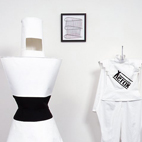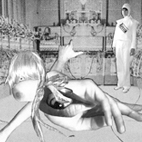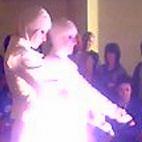The Future for Less [super 8mm and 16mm transferred to DVD, 10 min., 2006]
The Future for Less is a futuristic b-movie about a post IKEA riots society where art and high Modernist design have triumphed and Sunday DIY rituals are an underground cult. The film explores a distopian vision where Xerox drones (dressed in white suits and caps) patrol brutalist urban landscapes searching out high modern dissidents (in this case, dressed in a black suit with ziggurat-shaped shoulder pads). The suited rogue is stripped of the boxes of flat-pack furniture he was carrying and led into a den covered with constructivist sculpture. Supervised by the limb-less High-Priestess, the drones work with the furniture to imprison the man in his own geometrically spaced cage. The Future For Less presents an idiosyncratic mythological parable where the aesthetics of modernism form the foundation stones of a totalitarian religion. The film present a vision of a world where individuals who choose to erect Ikea DIY furniture are thwarted by an omniscient regime that insists on, and forcibly oversees the appropriation of these materials for use in only “good” modernist sculpture. The dominant governing forces in this world dispatch uniformed drones to enforce radical self-expression amongst the general populace. Here, the rhetoric of subversion and homogeneity are equated as a cultic-revolutionary B-movie farce, ironically transfiguring the operation of an ethics of freedom into a violent miasma. Amplifying this irony, the film self-consciously utilises a suitably ‘grainy’ film stock, and a provisional aesthetic for its mise en scene that mimics early twentieth century avant-garde film and theatre, reworking the Constructivist idealism of a collective imagination to produce a renewed bureaucraticized utopia of weekend flat-pack construction. The Future for Less was produced as part of the Cocheme Fellowship at Byam Shaw School of Art
Better Future, Wolf-Shaped [16mm transferred to DVD, 15 min., 2008]
In Better Future, Wolf-Shaped, a peripheral cult of worshipers fashions its own offerings to their Modernist ancestors in the form of architectural models of their great monuments made of corn husk. These are ritually constructed and burnt against the background of Celtic sites in Cornwall, as the group dons makeshift salad bowl and lampshade helmets, leading up to a choreographed homage to the square, a short dance routine juxtaposing Beckett’s television plays Quad I and II, Bruce Nauman’s Dance or Exercise on the Perimeter of a Square (Square Dance) and industrial German band Die Tödliche Doris’ song, “Tanz im Quadrat”. The transition between these two modes of sacrament sets up an aberrant chronology, destabilizing the temporal cohesion of the narrative as past utopia or future event. Bringing together pagan ritual, the anti-traditions of modernism and popular film and music interpretations of the cult as a social unit, Better Future, Wolf-Shaped aims to trace connections between historical moments as much as write its own chronology of an alternative future history. The appropriation of consumer culture and the relationship between the mass produced and the hand made and customised becomes a field for questioning the potential of art as political action. Like the previous film, for which Quebec band Les Georges Leningrad were commissioned to make a soundtrack, the film is soundtracked by a specially composed musical score by Steven Kado. Better Future, Wolf-Shaped has been produced with the support of Film London and the London Artists Film and Video Award.
The Future is Now [super 8mm and 16mm transferred to DVD, 23 min., 2009]
A lone insurgent is pursued by a representative of the state as she tries to assemble the multitude for a post-soviet mass spectacle. Hunted through the concrete cityscape of a multistory carpark and the brutalist architecture of the Barbican complex, she arrives at Edmonton with the motley crew of would be consumer revolutionaries, who come together to perform a choreography derived from footage of the original riot. Dressed in monochrome neo-constructivist Dada costumes, they form groupings, pushing boxes and gesticulating at fellow ‘shoppers’. Their repetitive movements converge in an ultimate confrontation with the uniformed police, which ends with the triumph of the flatpack utopia as the opposing forces join in a tableau of frozen victory. Exploring the possibility of collective action emerging from the Capitalist relations inherent in the consumer riot, the film forms an epic finale for the Future trilogy. Featuring music by Laibach. The Future is Now was commissioned by Collective Gallery, Edinburgh.




